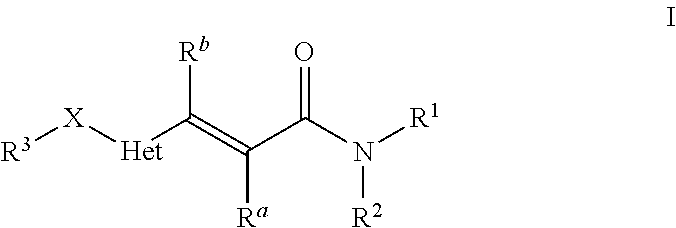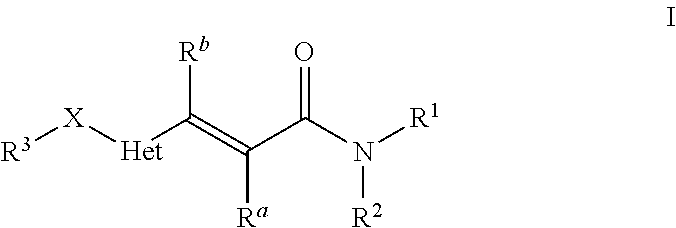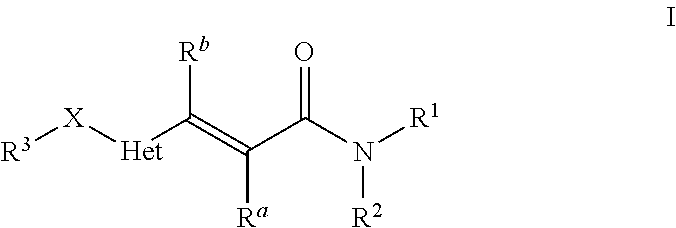Heteroarylacrylamides and their use as pharmaceuticals
a technology of heteroarylacrylamide and enos, which is applied in the field of heteroarylacrylamides, can solve the problems of further deterioration of pathology, and serious disturbance of the transcriptional and post-transcriptional mechanisms of enos regulation
- Summary
- Abstract
- Description
- Claims
- Application Information
AI Technical Summary
Benefits of technology
Problems solved by technology
Method used
Image
Examples
example 1
1-(Piperidin-1-yl)-3-(quinolin-3-yl)-propenone
[0157]
(a) 3-(Quinolin-3-yl)-acrylic Acid
[0158]1.006 g (6.4 mmol) of quinoline-3-carbaldehyde were dissolved in 10 ml of pyridine and 0.794 g (7.6 mmol) of malonic acid and 54 mg (0.6 mmol) of piperidine were added. The resulting solution was boiled under reflux for 6 h. The solution was allowed to cool to room temperature and kept for 16 h whereupon the product precipitated. The product was isolated by filtration. Yield: 0.765 g.
[0159]MS: m / e=200 (M+H)+
(b) 1-(Piperidin-1-yl)-3-(quinolin-3-yl)-propenone
[0160]0.25 g (1.3 mmol) of 3-(quinolin-3-yl)-acrylic acid, 1.445 g (12.5 mmol) of NEM and 453 mg (1.4 mmol) of TOTU were dissolved in 2 ml of DMF and stirred at room temperature for 15 min. 117 mg (1.4 mmol) of piperidine were added, and reaction mixture was stirred at room temperature for 16 h. The solvent was removed under reduced pressure. The residue was dissolved in ethyl acetate, and the solution was washed with a saturated aqueous so...
example 2
3-[5-(4-Chloro-phenyl)-thiophen-2-yl]-1-(piperidin-1-yl)-propenone
[0162]
(a) 3-(5-Bromo-thiophen-2-yl)-acrylic Acid
[0163]3 g (15.7 mmol) of 5-bromo-thiophene-2-carbaldehyde were dissolved in 30 ml of pyridine and 1.96 g (18.8 mmol) of malonic acid and 133 mg (1.6 mmol) of piperidine was added. The reaction mixture was boiled under reflux for 6 h. After cooling to room temperature, it was poured into a mixture of ice and concentrated aqueous hydrochloric acid whereupon the product precipitated. The product was isolated by filtration, dissolved in ethyl acetate, and the solution was washed with 0.1 M hydrochloric acid. The organic phase was dried with sodium sulfate, filtered and the solvent was removed under reduced pressure. Yield: 3.0 g.
[0164]MS: m / e=234 (M+H)+
(b) 3-[5-(4-Chloro-phenyl)-thiophen-2-yl]-acrylic Acid
[0165]0.250 g (1.1 mmol) of 3-(5-bromo-thiophen-2-yl)-acrylic acid and 61.9 mg (0.1 mmol) of tetrakis(triphenylphosphine)palladium were dissolved in 5 ml of degassed DME an...
example 3
3-[5-(4-Fluoro-phenyl)-thiophen-2-yl]-1-(piperidin-1-yl)-propenone
[0169]
(a) 3-(5-Bromo-thiophen-2-yl)-1-(piperidin-1-yl)-propenone
[0170]50 g (2.1 mmol) of 3-(5-bromo-thiophen-2-yl)-acrylic acid, 2.47 g (21.5 mmol) of NEM and 774 mg (2.4 mmol) of TOTU were dissolved in 5 ml of DMF and stirred at room temperature for 15 min. 201 mg (0.5 mmol) of piperidine were added, and the reaction mixture was stirred at room temperature for 16 h. The solvent was removed under reduced pressure. The product was purified by silica gel chromatography.
[0171]Yield: 458 mg.
[0172]MS: m / e=300 (M)+
(b) 3-[5-(4-Fluoro-phenyl)-thiophen-2-yl]-1-(piperidin-1-yl)-propenone
[0173]0.250 g (0.8 mmol) of 3-(5-bromo-thiophen-2-yl)-1-(piperidin-1-yl)-propenone and 48.1 mg (0.08 mmol) of tetrakis(triphenylphosphine)palladium were dissolved in 5 ml of degassed DME and stirred at room temperature for 10 min. 0.251 g (1.6 mmol) of 4-fluorophenylboronic acid and 1 ml of a 2 M aqueous sodium carbonate solution was added toget...
PUM
| Property | Measurement | Unit |
|---|---|---|
| RI | aaaaa | aaaaa |
| temperatures | aaaaa | aaaaa |
| temperatures | aaaaa | aaaaa |
Abstract
Description
Claims
Application Information
 Login to View More
Login to View More - R&D
- Intellectual Property
- Life Sciences
- Materials
- Tech Scout
- Unparalleled Data Quality
- Higher Quality Content
- 60% Fewer Hallucinations
Browse by: Latest US Patents, China's latest patents, Technical Efficacy Thesaurus, Application Domain, Technology Topic, Popular Technical Reports.
© 2025 PatSnap. All rights reserved.Legal|Privacy policy|Modern Slavery Act Transparency Statement|Sitemap|About US| Contact US: help@patsnap.com



